Georgian Civil War
| Georgian Civil War | ||||||||
|---|---|---|---|---|---|---|---|---|

 Location of Georgia (including Abkhazia and South Ossetia) and the Russian part of North Caucasus |
||||||||
|
||||||||
| Belligerents | ||||||||
|
|
|
|||||||
| Commanders and leaders | ||||||||
|
|
|
|
||||||
![]() Gamsakhurdia's government in exile
Gamsakhurdia's government in exile
The Georgian Civil War comprised inter-ethnic and intranational conflicts in the regions of South Ossetia (1988–1992) and Abkhazia (1992–1993), as well as the violent military coup d'état of December 22, 1991 - December 31, 1993, against the first democratically elected President of Georgia, Zviad Gamsakhurdia and his subsequent uprising in an attempt to regain power (1993).
While the Gamsakhurdia rebellion was eventually defeated, the South Ossetia and Abkhazia conflicts resulted in the de facto secession of both regions from Georgia. As a result, both conflicts have lingered on, with occasional flare-ups.
Ethnic minority separatist movements – primarily on the part of the Ossetians and the Abkhaz, demanded fuller recognition in the new order of the early 1990s. Asserting its newly gained national prerogatives, Georgia responded with military attempts to restrain separatism forcibly. On January 5, 1991 Georgia's National Guard entered Tskhinvali, South Ossetian capital and fighting broke out in and around the city. The Georgian-Ossetian Conflict was the first major crisis faced by Gamsakhurdia's government.
...
Wikipedia
